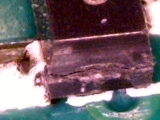|
|
|
|
|
|
|
|
|
|
|
|
| Ask the Experts | |||||||
|
|||||||
|
March 27, 2024 - Updated July 17, 2012 - Originally Posted Cause of Cracking on SOT23 Components
The cracks occur only at one place on the board, and components from the same reel are placed at three other positions without issues. I suppose board support is the most likely cause. Could there be any other explanation? B.A. |
|||||||
| Expert Panel Responses | |||||||
|
Since you indicate that this is a recent issue, it seems to me that something has changed in the process even if it seemed insignificant to whomever authorized it. Of course there are a lot of unknowns here and not a lot of information to go on, but the three top thoughts that immediately come to mind are warpage of the board fabrication especially with 0.031" substrates through reflow that could severely stress solder connections and component bodies resulting in destruction of the component. This could originate from changed reflow settings or something downstream at the board fabrication supplier impacting the board fabrication quality itself. Another thought is that the component and/or solder connections are being stressed through improper depanelization or singulation which can definitely cause this issue to occur again with thinner 0.031" substrates. Make certain that they are using a singulation system and that they're not being broken apart by hand under any circumstances! A final thought is that it could be originating from the packing process - perhaps something is physically contacting the component in packing or upstream during shipping. I think that the bottom line here is to realize that since this is a recent issue, something has changed in the process and needs to be corrected. Good luck!
Sales & Marketing Manager Technical Manufacturing Corp. David has been active in all areas of the contract electronics manufacturing industry for over fifteen years. He is currently in charge of all Sales and Marketing related activities for Technical Manufacturing Corporation.
It appears that there is some impact damage on the side of the component near the horizontal crack, although it is hard to tell from he single picture. The crack does not appear to be stress or heat related, although again it is hard to tell. If it only occurs in a single location and always on the same side of the part, it could be that as the CCAs slide down a ramp out of the reflow oven or out of the wash they are allowed to bang into the CCA in front of them, which would explain physical damage only toa SOT-23 near the trailing edge of the CCA, but not the others populated further inside. Take a good look under at 20x-30x scope, and see if you can verify any impact damage at the sides of the part. If it is impact damage, and it is severe enough to cause that type of cracking, there should be some type of telltale scratch or chip at the point of impact.
Advanced Engineer/Scientist General Dynamics Richard D. Stadem is an advanced engineer/scientist for General Dynamics and is also a consulting engineer for other companies. He has 38 years of engineering experience having worked for Honeywell, ADC, Pemstar (now Benchmark), Analog Technologies, and General Dynamics.
It seems that mechanical damage after placement is the most likely scenario. Is the problem position near a board edge by any chance? I'm wondering if the problem location is prone to damage from tooling used to rack or otherwise hold or support the boards? Also look at other points in the process where mechanical damage might happen at the problem location.
Process Engineer Astronautics Fritz's career in electronics manufacturing has included diverse engineering roles including PWB fabrication, thick film print & fire, SMT and wave/selective solder process engineering, and electronics materials development and marketing. Fritz's educational background is in mechanical engineering with an emphasis on materials science. Design of Experiments (DoE) techniques have been an area of independent study. Fritz has published over a dozen papers at various industry conferences.
As only some of the parts are cracking, I would measure the thermal profile of both the good and the affected bad parts and see if there is significant difference between the two. As we know, components can suffer from high temperature ramp rates and moisture penetration. It may be possible to correct the issue by altering the thermal profile or by pre-baking the components. This is only one possible cause ... There are others.
M.O.L.E. Line Product Manager Electronic Controls Design, Inc. (ECD) Mark Waterman is a trainer and field engineer with 17 years experience in service and applications specialties. Intimate knowledge of soldering processes and measurement systems. Six sigma and statistical process control generalist.
Reader Comment
If the same reference designator is the only one always damaged and is the only part on the board damaged then it is likely due to fixturing of some type. I would start by looking at each step in the process: support pins on your pick and place, how the board or panel sits in a board rack, clamping in your AOI machine, depanelization, test fixturing. Since it is only 1 location this is how I would approach it.
Clinton Buldrini, Matthew Associates
|
|||||||
| Submit A Comment | |||||||
|
Comments are reviewed prior to posting. You must include your full name to have your comments posted. We will not post your email address. |
|
Free Newsletter Subscription
Circuitnet is built for professionals who bear the responsibility of looking ahead, imagining the future, and preparing for it. Insert Your Email Address |
|
|
|
|
|
|
|
|




